
Musky Habitat, The Search for Musky Nirvana - Jeff Sundin
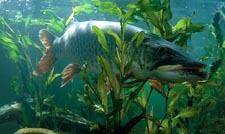 As anglers become more mobile, better equipped and more knowledgeable, the idea of catching trophy fish is gaining in popularity. Because of this fishes large size and the allure of catching the reputed “fish of ten thousand casts”. The Musky has drawn the attention of lots of these thrill-seeking anglers. All this attention has been great for Musky devotees because there’s been an explosion of new fishing gear, lures, videos and a growing assortment of contraptions intended to make it easier to get a trophy into the boat.
As anglers become more mobile, better equipped and more knowledgeable, the idea of catching trophy fish is gaining in popularity. Because of this fishes large size and the allure of catching the reputed “fish of ten thousand casts”. The Musky has drawn the attention of lots of these thrill-seeking anglers. All this attention has been great for Musky devotees because there’s been an explosion of new fishing gear, lures, videos and a growing assortment of contraptions intended to make it easier to get a trophy into the boat.
The problem is that along with all of the added attention, comes the demand for more fish, more fishing water and more action. In Minnesota the demand for places to fish Muskies is outpacing the supply of “new water” and so the questions naturally come up, how do we preserve the quality of existing Musky fisheries? And where can we look to provide new Musky fishing opportunities?
At first glance, the solution seems simple, just stock a bunch of lakes with Muskies and you’re in business, right? Sorry pal, it’s a little more complicated than that. Even though a single adult female Musky has the potential to drop as many as 200,000 eggs during the spring spawn, Musky populations in even really good lakes is still low. Population densities are still being studied, but even looking at the most optimistic data, in most Musky lakes there’s probably only about one Musky per every 5 to 10 acres of water.
At that rate, a 2500-acre lake with great natural reproduction and lots of food still only supports about 500 adult fish. Obviously, it takes a lot of luck to become an adult Musky and even more important, it requires great habitat. Understanding the elements that make Musky habitat will be the key to discovering opportunities to strengthen existing fisheries and develop new ones in the future.
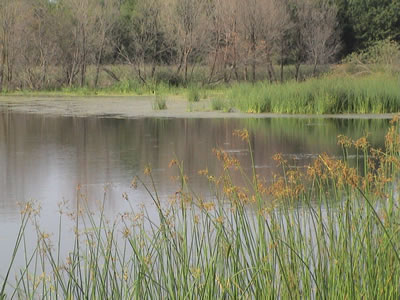 For all fish, life begins with good spawning habitat. Undisturbed shoreline is likely the key to successful natural reproduction. Early research by the University of Michigan and the Michigan DNR showed that lakes with self-sustaining populations of Musky were generally surrounded by forest and contained more acres of shoreline. Lakes that were more developed or had fewer acres of shoreline required constant stocking to maintain fishable populations of Musky. Developed shoreline is not automatically bad, but often times, too many of the native weeds are removed, leaving little if any cover for Muskies to spawn. Muskies are adaptable though and if shoreline cover is undisturbed, they can use a variety of shoreline covers for spawning.
For all fish, life begins with good spawning habitat. Undisturbed shoreline is likely the key to successful natural reproduction. Early research by the University of Michigan and the Michigan DNR showed that lakes with self-sustaining populations of Musky were generally surrounded by forest and contained more acres of shoreline. Lakes that were more developed or had fewer acres of shoreline required constant stocking to maintain fishable populations of Musky. Developed shoreline is not automatically bad, but often times, too many of the native weeds are removed, leaving little if any cover for Muskies to spawn. Muskies are adaptable though and if shoreline cover is undisturbed, they can use a variety of shoreline covers for spawning.
Muskies spawn at around 55 degrees so ideal spawning sites are located in shallow, flat, marshy areas usually lees than 3 feet in depth. Protection from wind and colder main lake water temperatures make isolated bays, islands and small creek inlets all good spawning sites. Bulrush, Chara, tree branches and other shallow woody cover are all good. In some regions, sediment rich bottom content covered with leafy debris or wood particles appear to be useful, but according to some fisheries experts, mixed sand and gravel may be better.
Most spawning sites are about 150 feet in length but can range from 30 to over 10,000 feet. Unlike the Northern Pike whose eggs are sticky and cling to vegetation, Musky eggs fall freely to the bottom, so silted or excessively soft bottom areas would be undesirable.
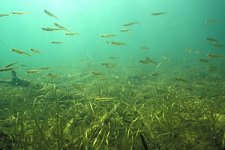 Once hatched, Musky fry, fingerlings and small fish remain almost exclusively in fairly heavy weed cover. The type of weed cover can vary, but open sand beaches or other barren shoreline areas are of little value to young fish. Later, adult fish will use these shallow sand areas to recover from spawning or occasionally to warm themselves in the sun.
Once hatched, Musky fry, fingerlings and small fish remain almost exclusively in fairly heavy weed cover. The type of weed cover can vary, but open sand beaches or other barren shoreline areas are of little value to young fish. Later, adult fish will use these shallow sand areas to recover from spawning or occasionally to warm themselves in the sun.
The importance of a forage base suitable to Muskies is critical to developing or sustaining a healthy fishery. During early development, young fish can eat whatever they have on hand. Any minnows and small fish that inhabit the shallow weeds are good. But as the Musky develops into adulthood, Muskies can go wherever they want and forage of their preferred size becomes increasingly important. Muskies are adaptable and could eat panfish, Walleye and Perch. But if present, they’ll prefer larger soft body forage like Smelt, Suckers, Tulibees, Whitefish and Burbot. Actively feeding Muskies often roam deeper open water and feed on these larger forage species, returning to shallow cover that they use as resting areas.
One common perception among anglers is that Muskies eat too many of our favorite game fish species, but this could be misguided thinking. According to a Minnesota DNR study (easily found on the MN DNR website), the report shows that the presence of Muskies has little affect on most of our favorite sport fish.
Walleye test catch rates were actually higher in 18 of the 41 survey lakes after the introduction of Muskies. To be fair, there are some examples of declines in Walleye test catches too, but an overall summary of the median catch rates of all 41 lakes pooled together showed that for most sport fish species, populations were slightly higher after Muskies were stocked than before they were stocked.
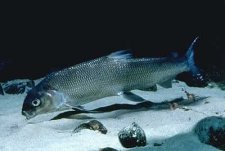 Average catch rates of forage species like Tulibee and Suckers do show a slight decline. So this appears to support the notion that adult Muskies, given the option, would prefer to feed on these rather than to select the game fish that many anglers seek to protect.
Average catch rates of forage species like Tulibee and Suckers do show a slight decline. So this appears to support the notion that adult Muskies, given the option, would prefer to feed on these rather than to select the game fish that many anglers seek to protect.
Another interesting side point about the Muskie’s affect on other game fish is that the average size of Northern Pike appears to increase when Muskies are present. It’s possible that Muskies eat a portion of the smaller, hammer handle size pike that plague so many of our lakes these days. For many, the idea that Muskies could help control the small Pike would be enough incentive to lobby the DNR for a truckload of fingerlings.
If we were to design a truly great, new Musky fishery, we’d add one more element. Lets make our lake a little bit larger than average. According to an Ontario study, larger lakes tend to be better environments to produce trophy size fish. While smaller lakes will support Muskies, the likelihood of producing really large, trophy fish is better on a really large lake.
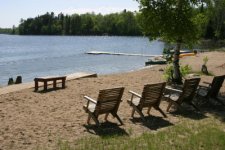 Whether the competition for food limits their growth or if they just need more space to set up a good home territory isn’t clear, but we already know that many of the already existing prime Musky fisheries in the Midwest are larger lakes. If the goal is to add lakes to be managed for Musky, it makes common sense to look at these larger lakes first.
Whether the competition for food limits their growth or if they just need more space to set up a good home territory isn’t clear, but we already know that many of the already existing prime Musky fisheries in the Midwest are larger lakes. If the goal is to add lakes to be managed for Musky, it makes common sense to look at these larger lakes first.
What’s good for the Musky, is good for the lake too. Developed shoreline areas like this sandy beach are of little value to either spawning or juvenile Muskies. At times, adult fish may bask in the sun to warm up along a shallow beach, especially just after the spawning run in spring, but they have no intention of permanently living in these areas.
Take a look, however briefly at what makes a good Musky lake and you’ll conclude that anyone who wants to see Muskies thrive must also be an advocate for habitat. As it happens, many of the attributes that make up great Musky habitat turn out to be good for other fish and forage species, not to mention the added benefit of preserving water quality.
I don’t know about you, but for me, seeing a musky in the water is a thrill. Even if I never fished for a single Musky, I’d still get goose bumps seeing a big one swimming past the end of my dock.
Jeff Sundin is a full time, professional fishing guide, outdoor writer and photographer. Book Jeff for guided fishing trips, for fishing seminars, fishing promotions and media events. Click here >> learn more about Jeff Sundin.
"The Early Bird Fishing Guide" Jeff Sundin - Fishing Blue Books, LLC 715 Byington Ave, LaPrairie, MN 55744 218-245-9858
Email copyright©2018 Fishing Blue Books, LLC All Rights Reserved - last revised 03-27-18